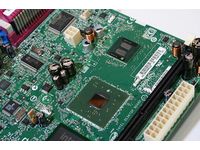Intel Now Shipping Dual-Core Atom 330 Processors
Intel has official begun shipping its new Atom Processor 330, a 45 nm dual-core processor for nettops.
On Friday, Intel officially began shipping its 45 nm Intel Atom Processor 330, Intel’s first Atom processor to feature dual-cores. With a 1.6 GHz clock-speed, 1 MB of L2 cache and support for DDR2 667, the Atom 330 looks like Intel just combined two Atom 230 processors. The added core does double the processor’s TDP unfortunately, an increase from 4 W to 8 W.
The Atom 330 will be available as an integrated part of the new Intel D945GCLF2 desktop motherboard, which features the Intel 945GC Express Chipset, Intel GMA 950 integrated graphics and a 533 MHz system bus. The Intel D945GCLF2 motherboard also offers a S-Video connector, gigabit Ethernet, 6-channel high definition audio and a single DIMM socket supporting up to 2 GB of DDR2 667/533 memory.
Intel Atom processors have been specifically designed by Intel to be extremely power-efficient, however many sacrifices were made to achieve this balance between performance and power. It turns out that multi-threading greatly helps Atom processors overcome the effects of some of the sacrifices that were made. As a result, Atom processors that use Hyper-Threading technology see large performance gains and the use of two actual cores along with Hyper-Threading, as used in the Atom 330, should result in even greater gains.
Intel has designed the Atom 330 for use in nettops, which are entry-level, Internet-centric desktop PCs. It is likely that a dual-core Atom processor will eventually make its way into the mobile market, but Microsoft may not allow Windows XP to be sold on such a system. Intel Atom processors are facing strong competition, such as from Via’s Nano processors and offerings by AMD.
Get Tom's Hardware's best news and in-depth reviews, straight to your inbox.
-
martel80 Replybut Microsoft may not allow Windows XP to be sold on such a system.
Who cares? You will not game/develop on it so Linux is more than enough. -
apache_lives more people out there dont know how to use linux! all us on here maybe but that speaks for the mere like 1% but i know what your saying.Reply
2gb and vista basic with this dual core might JUST run (it will run, but performance wise for every day use...)
this could be an interesting piece of hardware -
nekatreven I personally think it makes them look bad in some ways. Think how recent it was that a dual core processor approaching 2.0ghz was a pretty good chip. As a matter of fact thats still a pretty good chip.Reply
I realize that the architecture is probably different and these aren't C2Ds or Athlons...and I suppose the thermal loss may be exponential for faster chips...the small die of the atom may just be due to the reduced cache size...all that and whatever.
But still, they have a dual core 1.6 with 1mb of L2 in a die package this small that runs on 8W!! The greatest and fastest processors of the day are huge compared to these and suck tons of power, and yet the performance gains scale in much smaller proportions (even if you consider architecture and not just numbers).
I think it just blatantly points out how much more work can and should be done on todays top end chips to shrink them and reduce their power needs, which in a way is a really good thing. -
martel80 apache_livesmore people out there dont know how to use linux! all us on here maybe but that speaks for the mere like 1% but i know what your saying.Have you ever seen the iPhone-like UI of the EEE PC Linux (Xandros)? All the Linux nettops are likely to come with a version of Linux that is intuitive and works out of the box, no terminal voodoo involved. :)Reply -
I agree with WheelsOfConfusion, the chipset that these are on is absolutely TERRIBLE. Sure, the processor has a low thermal envelope, but the chipset is extremely wasteful on heat and power.Reply
-
martin0642 Offerings such as VIA Nano?!Reply
When I am able to go to Newegg and buy a Nano L2100 @ 1.8GHz and pair it with a suitable motherboard, then it's competing. Currently it seems they just have integrated 1-1.5GHz versions that are fixed to the motherboard itself. The motherboards are also much more expensive than their Intel/AMD/NVidia counterparts while offering less capabilities. Until you can buy what they advertise on their site, and buy them separate from each other, I don't think it's going to be a big threat to either Intel or AMD. Conceptually I'm all for the Nano, but it seems like mostly vaporware.
Maybe it's the digital-signage market eating them all up faster than VIA can make them. -
apache_lives martel80 good point there but what i mean is like they want to download there applications and itunes and whatever bs and it wont run etc, thats what everyone wants.Reply
lol 8w cpu 20+ w chipset yey, what do you expect from a netburst era chipset -
WheelsOfConfusion martin0642Offerings such as VIA Nano?!When I am able to go to Newegg and buy a Nano L2100 @ 1.8GHz and pair it with a suitable motherboard, then it's competing. Currently it seems they just have integrated 1-1.5GHz versions that are fixed to the motherboard itself.You do realize that the Atom is also BGA (soldered instead of using pins) and not socketed? In netbooks, handhelds, and MIDs, a socketed processor doesn't make sense yet. Even in super low-cost desktops or "nettops," the processors are likely to be soldered directly in place for cost reasons.Reply
That's what both the Atom and the Nano are aimed at right now. Unless somebody has information on a socketed version of the Atom that I've missed.
